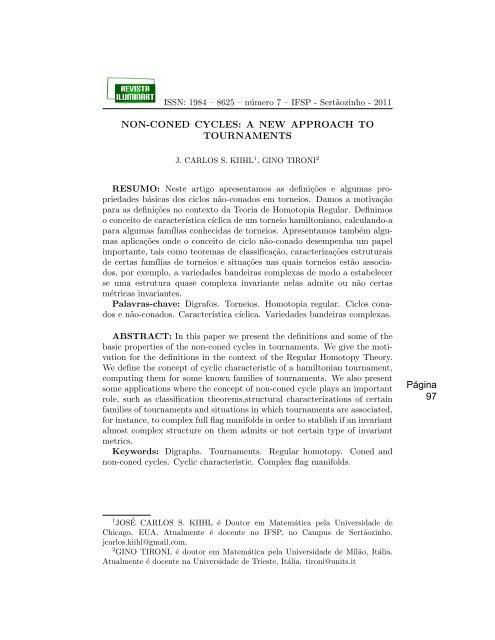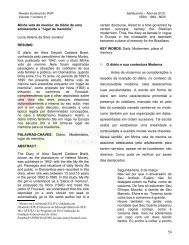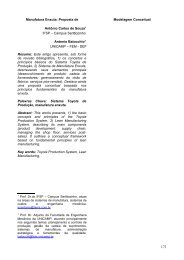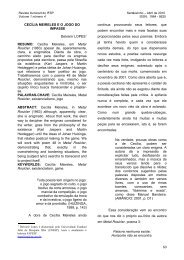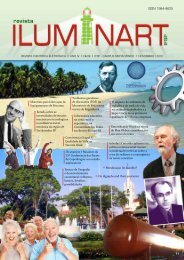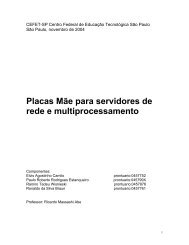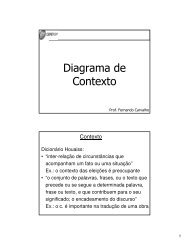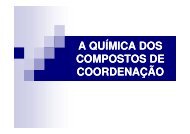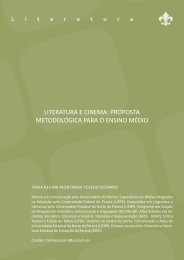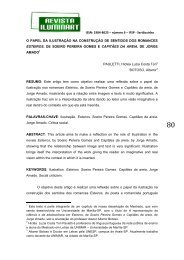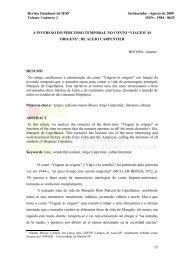Página 97
Página 97
Página 97
You also want an ePaper? Increase the reach of your titles
YUMPU automatically turns print PDFs into web optimized ePapers that Google loves.
ISSN: 1984 – 8625 – número 7 – IFSP - Sertãozinho - 2011<br />
NON-CONED CYCLES: A NEW APPROACH TO<br />
TOURNAMENTS<br />
J. CARLOS S. KIIHL 1 , GINO TIRONI 2<br />
RESUMO: Neste artigo apresentamos as definições e algumas propriedades<br />
básicas dos ciclos não-conados em torneios. Damos a motivação<br />
para as definições no contexto da Teoria de Homotopia Regular. Definimos<br />
o conceito de característica cíclica de um torneio hamiltoniano, calculando-a<br />
para algumas famílias conhecidas de torneios. Apresentamos também algumas<br />
aplicações onde o conceito de ciclo não-conado desempenha um papel<br />
importante, tais como teoremas de classificação, caracterizações estruturais<br />
de certas famílias de torneios e situações nas quais torneios estão associados,<br />
por exemplo, a variedades bandeiras complexas de modo a estabelecer<br />
se uma estrutura quase complexa invariante nelas admite ou não certas<br />
métricas invariantes.<br />
Palavras-chave: Digrafos. Torneios. Homotopia regular. Ciclos conados<br />
e não-conados. Característica cíclica. Variedades bandeiras complexas.<br />
ABSTRACT: In this paper we present the definitions and some of the<br />
basic properties of the non-coned cycles in tournaments. We give the motivation<br />
for the definitions in the context of the Regular Homotopy Theory.<br />
We define the concept of cyclic characteristic of a hamiltonian tournament,<br />
computing them for some known families of tournaments. We also present<br />
some applications where the concept of non-coned cycle plays an important<br />
role, such as classification theorems,structural characterizations of certain<br />
families of tournaments and situations in which tournaments are associated,<br />
for instance, to complex full flag manifolds in order to stablish if an invariant<br />
almost complex structure on them admits or not certain type of invariant<br />
metrics.<br />
Keywords: Digraphs. Tournaments. Regular homotopy. Coned and<br />
non-coned cycles. Cyclic characteristic. Complex flag manifolds.<br />
1 JOSÉ CARLOS S. KIIHL é Doutor em Matemática pela Universidade de<br />
Chicago, EUA. Atualmente é docente no IFSP, no Campus de Sertãozinho.<br />
jcarlos.kiihl@gmail.com.<br />
2 GINO TIRONI, é doutor em Matemática pela Universidade de Milão, Itália.<br />
Atualmente é docente na Universidade de Trieste, Itália. tironi@units.it<br />
<strong>Página</strong><br />
<strong>97</strong>
1. Introduction<br />
ISSN: 1984 – 8625 – número 7 – IFSP - Sertãozinho - 2011<br />
Tournaments are for sure the most well-studied class of digraphs.<br />
There are hundreds of research papers written on this subject. In this<br />
paper we present the concepts of coned and non-coned cycles, which<br />
seem to provide a new and efficient instrument to study tournaments,<br />
specially the hamiltonian ones (which the majority of them). These<br />
concepts came up in a natural way in the development of the Regular<br />
Homotopy Theory for digraphs. In the case of tournaments, as we<br />
intend to show here, the concept of non-coned cycle leads to some very<br />
interesting and important results.<br />
In section 2 we present the basic definitions, introducing the<br />
notation and stating some basic results about digraphs.<br />
In section 3 we recall some of the main concepts and results<br />
of the regular homotopy for digraphs as it was introduced by Burzio,<br />
Demaria and Garbaccio-Bogin (see [4], [6], and [12]).<br />
In section 4 we define the concepts of coned and non-coned cycle,<br />
giving their motivation in the context of regular homotopy theory.<br />
In section 5 we show how the concept of coned cycle can be<br />
used in several situations if one is interested in classification results<br />
or in structural characterizations of certain families of tournaments<br />
and also, as it has been seen lately, in those situations in which<br />
tournaments are associated to complex full flag manifolds in order to<br />
stablish if an invariant almost complex structure on them admits or<br />
not certain type of invariant metrics. .<br />
2. Preliminaries<br />
In this section we give some definitions and recall some well<br />
known results on digraphs.<br />
Definition 2.1 Let V be a finite non-empty set and E a set of<br />
ordered pairs (u, v) ∈ V × V , such that u = v. We call the pair<br />
D = (V, E) a directed graph or digraph. The elements of V are the<br />
vertices of D, the cardinality of V the order of D, and the elements of<br />
E the arcs of D. Moreover we write u → v instead of (u, v), and we<br />
<strong>Página</strong><br />
98
ISSN: 1984 – 8625 – número 7 – IFSP - Sertãozinho - 2011<br />
call u a predecessor of v and v a successor of u.<br />
Remark 1. Given two distinct vertices u and v we have a priori four<br />
possibilities, and then four types of arcs:<br />
(1) There is no oriented arc between u and v, and then we shall<br />
denote u|v the null arc;<br />
(2) there is the oriented arc (u, v), but not the arc (v, u), and then<br />
we shall denote the simple arc u → v;<br />
(3) there is the oriented arc (v, u), but not the arc (u, v), and then<br />
we shall denote the simple arc u ← v;<br />
(4) there are both oriented arcs (u, v) and (v, u), and then we shall<br />
denote the double arc u ↔ v. (A double arc is also called a 2-cycle or<br />
a symmetric pair.)<br />
Definition 2.2 A digraph is called oriented if, between two distinct<br />
vertices, there is at most one ordered arc – that is, the possible arcs<br />
are either simple arcs or null arcs; a digraph is called a non-oriented<br />
graph if, between two distinct vertices, there is either a double arc or<br />
a null arc. A digraph is called semicomplete if, between two distinct<br />
vertices, there is at least one ordered arc; the possible arcs in this case<br />
are either simple or double arcs.<br />
Definition 2.3 A digraph T is a tournament if, between every pair<br />
of distinct vertices, there is one and only one arc. A tournament T<br />
is called hamiltonian if it contains a spanning cycle – that is a cycle<br />
passing through all vertices of T . If the cardinality |V (T )| = n, we say<br />
that T has order n. For the sake of brevity we will identify Tn with<br />
its vertex set V (Tn) = {v1, . . . , vn}. We denote by Tn − v the vertex<br />
deleted tournament and by < C > the subtournament < V (C) ><br />
induced by the vertices of the cycle C of T . Moreover A → B denotes<br />
that the vertices of a subtournament A are predecessors of the vertices<br />
of the subtournament B in Tn.<br />
Definition 2.4 A vertex v cones a subtournament T ′ in Tn (or<br />
equivalently, T ′ is coned by v) if and only if either v → T ′ or T ′ → v.<br />
Otherwise T ′ is said to be non-coned in Tn. If C is a cycle in Tn, we say<br />
that C is coned by v (or equivalently, v cones C) if < C > is coned by v.<br />
Definition 2.5 A subtournament S of T is an e-component of T ,<br />
and its vertices are all called equivalent, if S is coned by each vertex<br />
of T \ S. Single vertices of T are trivial e-components.<br />
<strong>Página</strong><br />
99
ISSN: 1984 – 8625 – número 7 – IFSP - Sertãozinho - 2011<br />
We have the notion of quotient tournaments (see [24]), that<br />
can also be described in the following way: Every tournament Tn<br />
can be partitioned (in a non-trivial way) into disjoint e-components<br />
S (1) , S (2) , . . . , S (m) . These components can be considered as the<br />
vertices w1, w2, . . . , wm of a tournament Rm, so that Tn can be<br />
obtained as the composition Rm(S (1) , S (2) , . . . , S (m) ) of the ecomponents<br />
S (1) , S (2) , . . . , S (m) with the quotient Rm. In other words<br />
Tn = S (1) ∪ S (2) ∪ · · · ∪ S (m) and a → b in Tn if and only if a → b<br />
in some S (j) or a ∈ S (j) , b ∈ S (k) and wj → wk in Rm (i.e. S (j) → S (k) ).<br />
A tournament Tn is simple if it has no non-trivial e-components.<br />
In other words, if Tn = Rm(S (1) , S (2) , . . . , S (m) ) is simple then either m<br />
= n or m = 1.<br />
A subtournament T ′ of T is called shrinkable if it is included in<br />
a non-trivial e-component of Tn. If < C > is shrinkable in Tn, then we<br />
say the cycle C is shrinkable in Tn (see [5]).<br />
We recall the following results about quotient tournaments:<br />
Proposition 2.6 The quotient tournament Rm is isomorphic to a<br />
subtournament of Tn.<br />
Proposition 2.7 Every tournament Tn, with n ≥ 2, admits exactly<br />
one simple quotient tournament.<br />
Proposition 2.8 A tournament Tn is hamiltonian if, and only if,<br />
every one of its quotient tournaments is hamiltonian.<br />
3. Regular Homotopy for Digraphs<br />
In this section we recall some of the basic concepts and results<br />
on the regular homotopy for digraphs (see [4], [6] and [12]).<br />
We can, in a natural way, consider a digraph D as a pretopological<br />
space ( Čech closure space) P (D). We just have to<br />
consider the principal filter generated by the closed neighbourhoods<br />
N[v] = {v} ∪ {w ∈ D|v → w} as the neighbourhoods filter of any<br />
<strong>Página</strong><br />
100
ISSN: 1984 – 8625 – número 7 – IFSP - Sertãozinho - 2011<br />
vertex v of D. Then introducing precontinuous functions and a homotopy<br />
theory for digraphs, similar to the classical one for topological<br />
spaces, can be developed (see [12]). The precontinuous maps from a<br />
topological space into the pretopological space P (D) are the O-regular<br />
maps considered in [2], [3] or [4].<br />
In [4] Burzio and Demaria proved that the regular homotopy<br />
groups Qn of P (D) are isomorphic to the classical homotopy groups πn<br />
of the polyhedron of a suitable simplicial complex KD associated with<br />
D. That is<br />
Qn(D, v) ∼ = πn(|KD|, v) .<br />
We shall describe shortly how to get this suitable simplicial<br />
complex KD.<br />
If H ⊂ D we say H is headed if there exists a vertex v in H such<br />
that v → H \ v. And H is said to be totally headed if for every A ⊂ H<br />
with A = ∅, we have that A is headed. The simplexes in KD are the<br />
ones generated by the totally headed subdigraphs of D.<br />
4. Coned cycles in a Tournament<br />
In this section we shall take a closer look at the concept of coned<br />
cycles in a tournament T . We will show how this concept relates to<br />
some of the homotopical properties of T .<br />
First of all, we recall (see [6]) that for a tournament T the<br />
simplicial complex KT associated is such that its 0-simplices are given<br />
by the vertices ot T , and all other simplices are given as follows:<br />
S = (v1, . . . , vn) ∈ KT if and only if the subtournament < v1, . . . , vn ><br />
induced by the vertices v1, . . . , vn is transitive.<br />
As it is stated in the previous section, the regular homotopy<br />
n-dimensional group Qn(T ) of the tournament T is isomorphic to the<br />
classical homotopy group Πn(|KT |) of the polyhedron |KT | associated<br />
to the simplicial complex KT .<br />
Let a cycle C : v1 → v2 → · · · → vr → v1 be coned by a vertex<br />
v in T ; let, for instance C → v.<br />
<strong>Página</strong><br />
101
ISSN: 1984 – 8625 – número 7 – IFSP - Sertãozinho - 2011<br />
We can see that all the subtournaments S i =< vi, vi+1, v > with<br />
vi, vi+1 in C, are transitive. Therefore (vi, vi+1, v) ∈ KT and hence the<br />
cycle C is nullhomotopic.<br />
In the case C is contained in an e-component of T , then C<br />
is coned, hence nullhomotopic, and we say the cycle C is shrinkable.<br />
This fact that all the coned cycles are nullhomotopic in the<br />
context of the regular homotopy for digraphs has called attention<br />
to the non-coned cycles, whose concept was essential to prove<br />
very significant new results about hamiltonian tournaments as we<br />
shall show in the several applications that are given in the next section.<br />
5. Some Applications<br />
In [6] Burzio and Demaria used regular homotopic methods for<br />
characterizing tournaments which are the composition of a non-trivial<br />
highly regular tournament.<br />
Definition 5.1 A tournament T2m+1 is highly regular if we can<br />
label its vertices v1, v2, . . . , v2m+1 in such a way that vi → vj, for all<br />
i = 1, 2, . . . , 2m + 1 and for all j = i + 1, i + 2, . . . , i + m( mod 2m + 1).<br />
In other words, T2m+1 is highly regular if there is a cyclic ordering<br />
v1, v2, . . . , v2m+1, v1 of its vertices such that vi → vj if and only if vj is<br />
one of the first m successors of vi in the cyclic ordering of the vertices<br />
of T2m+1.<br />
Definition 5.2 A tournament T is said to be simply disconneceted<br />
if its fundamental group Q1(T ) is not trivial.<br />
Burzio and Demaria characterized the simply disconnected<br />
tournaments proving the following result:<br />
Theorem 5.1 A tournament T is simply disconnected if and only<br />
if T is the composition of any tournaments with a non-trivial highly<br />
regular tournament (i.e. Tn = Rk(S (1) , . . . , S (k) ), where S (i) are<br />
arbitrary tournaments and Rk is a highly regular tournament).<br />
(See Theorem 3.9, in [6]).<br />
<strong>Página</strong><br />
102
ISSN: 1984 – 8625 – número 7 – IFSP - Sertãozinho - 2011<br />
They also gave a different characterization for the tournaments<br />
which are simply disconnected, proving the following:<br />
Theorem 5.2 A tournament T is simply disconnected if and ony if<br />
(a) there exists a non-coned 3-cycle;<br />
(b) all the coned 3-cycles are shrinkable.<br />
(See Theorem 7, in [5]).<br />
Remark 5.1 It was in this paper that Burzio and Demaria<br />
introduced for the first time the concept of coned and non-coned<br />
3-cycles, which was later on generalized to cycles and sub-tournaments.<br />
Definition 5.3 Let Hn be a hamiltonian tournament. A vertex v<br />
of Hn is called a neutral vertex of Hn if Hn \ v is hamiltonian. The<br />
number of the neutral vertices of Hn is denote by ν(Hn).<br />
Remark 5.2 We observe that ν(Hn) is also the number of hamiltonian<br />
subtournaments of order n − 1, so we have that ν(Hn) ≤ n, for<br />
we can have at most n subtournaments of order n − 1. On the other<br />
hand, in [26] Moon proved that the minimum number of k-cycles, with<br />
3 ≤ k ≤ n, in a hamiltonian tournament Hn is equal to n − k + 1.<br />
Hence we have that ν(Hn) ≥ 2, if n ≥ 4. Therefore, we have that<br />
2 ≤ ν(Hn) ≤ n, for n ≥ 4.<br />
Another application of the concept of non-coned cycle was given<br />
in [7]. We have the following:<br />
Theorem 5.3 A tournament Hn (n ≥ 5) is hamiltonian if and only<br />
if there exists an m-cycle C, with 3 ≤ m ≤ n − 2, which is non-coned<br />
in Hn.<br />
Proof:<br />
Let us suppose Hn is hamiltonian. Let v be a neutral vertex<br />
of Hn and v1, v2 two neutral vertices of Hn \ v. Let us suppose by<br />
contradiction that the two hamiltonian subtournaments Hn \ {v, v1}<br />
and Hn \ {v, v2} are both coned. Since v1 cannot cone Hn \ {v, v1}<br />
(otherwise Hn \ {v, v1} is not hamiltonian), and v2 cannot cone<br />
Hn \ {v, v2} (otherwise Hn \ {v, v2} is not hamiltonian), then both<br />
Hn \ {v, v1} and Hn \ {v, v2} are coned by v. Hence v cones Hn \ v,<br />
which is a contradiction since Hn is hamiltonian. Therefore at least<br />
one of the two subtournaments Hn \ {v, v1} and Hn \ {v, v2} is<br />
<strong>Página</strong><br />
103
ISSN: 1984 – 8625 – número 7 – IFSP - Sertãozinho - 2011<br />
non-coned. In other words, in Hn there exists at least one non-coned<br />
(n − 2)-cycle. Conversely, if Tn is not hamiltonian, then its simple<br />
quotient is T2. Hence every cycle of Tn is included in an e-component,<br />
and therefore it is coned.<br />
Remark 5.3 Also H3 and H4 contain non-coned m-cycles, but in<br />
this case the condition m ≤ n − 2 is not satisfied.<br />
If C is a non-coned cycle of Hn and v ∈ V (C), then it is possible<br />
to extend C to a cycle through all the vertices of Hn \ v. This fact<br />
motivated Burzio and Demaria (see [7]) to define:<br />
Definition 5.4 Let C be a non-coned cycle of Hn. The set<br />
Pc = V (Hn) \ V (C) consists of neutral vertices of Hn, and these are<br />
called poles of C. A non-coned cycle C of Hn is said to be minimal<br />
if every cycle C ′ , such that V (C ′ ) ⊂ V (C), is coned by at least<br />
one vertex of Hn. A minimal cycle is said to be characteristic if it<br />
possesses the shortest length of the minimal cycles. The length of<br />
a characteristic cycle is called the cyclic characteristic of Hn and it<br />
is denoted by cc(Hn). The difference n − cc(Hn) is called the cyclic<br />
difference of Hn and is denoted by cd(Hn).<br />
We observe that if C is a characteristic cycle of Hn, then<br />
cd(Hn) = |Pc|.<br />
Using these definitions and the result given in Theorem 5.3,<br />
Burzio and Demaria in [7] gave a classification for the collection Hn<br />
of all the hamiltonian tournaments of order n ≥ 5, subdividing it in<br />
n − 4 different classes. Namely, the first class of cyclic characteristic 3<br />
is formed by the tournaments which contain a non-coned 3-cycle; the<br />
second one of cyclic characteristic 4 consists of the tournaments which<br />
contain a non-coned 4-cycle and whose 3-cycles are all coned. And so<br />
on, till the (n-4)th class of cyclic characteristic (n-2) which consists<br />
of the tournaments containing a non-coned (n − 2)-cycle and whose<br />
cycles with lower length are all coned.<br />
Formally we have the following:<br />
Theorem 5.4 Let Hn, with n ≥ 5, be a hamiltonian tournament,<br />
then 2 ≤ cd(Hn) ≤ n − 3 (or equivalently 3 ≤ cc(Hn) ≤ n − 2).<br />
Conversely, for every n ≥ 5 and for every h such that 2 ≤ h ≤ n − 3,<br />
<strong>Página</strong><br />
104
ISSN: 1984 – 8625 – número 7 – IFSP - Sertãozinho - 2011<br />
there exist hamiltonian tournaments Hn with cd(Hn) = h.<br />
This classification theorem for the hamiltonian tournaments<br />
has led to some important recent results. This is due to the fact<br />
this new invariant cc(Hn) (cyclic characteristic) can be obtained in a<br />
combinatorial way (just using the adjacency data) other then having<br />
some nice properties, like the one given in the next proposition.<br />
Proposition 5.1 If a tournament Tn is the composition<br />
Rm(S (1) , S (2) , . . . , S (m) ), then cc(Tn) = cc(Rm).<br />
These last two results have allowed to obtain the structural<br />
characterization of some important classes of hamiltonian tournaments<br />
as one can see by results we present now.<br />
In 1989 Demaria and Gianella defined Tn to be a normal<br />
tournament if it is hamiltonian and has a unique characteristic cycle.<br />
In [11] they throughly studied this class of tournaments, which turned<br />
out to be very important in some structural characterization theorems<br />
for other classes of tournaments.<br />
We present here some of the most important properties of the<br />
normal tournaments.<br />
Definition 5.5 The tournament An, with n ≥ 4, such that<br />
V (An) = {a1, a2, . . . , an} and V (An) = {ai → aj |j < i−1 or j = i−1}<br />
is called the bineutral tournament of order n.<br />
Remark 5.4 It is known that An is the unique tournament having<br />
exactly two neutral vertices. Moreover, for n ≥ 5, {an−1, an, a1, a2} is<br />
its maximal transitive subtournament, formed by consecutive vertices<br />
of the hamiltonian cycle. It is easy to see that a2, → · · · → an−1 → a2<br />
is the only minimal cycle (the characteristic one).<br />
We also observe that cc(A4) = 3, with two minimal cycles, so that<br />
it is not normal.<br />
In [13] Demaria and Gianella have also shown that a normal<br />
tournament Hn has as its characteristic cycle either the 3-cycle or<br />
a bineutral tournament Ak (n ≥ 4). In the same paper they have<br />
proofed the following:<br />
<strong>Página</strong><br />
105
ISSN: 1984 – 8625 – número 7 – IFSP - Sertãozinho - 2011<br />
Proposition 5.2 Let Hn be a normal tournament with cyclic<br />
characteristic k (k ≥ 3) and let Ak be its characteristic cycle. A pole<br />
z, associated to Ak, must have the following adjacencies with respect<br />
to Ak:<br />
1) (ai+1, ai+2, . . . , ak) → z → (a1, a2, . . . , ai) (1 ≤ i ≤ k − 1).<br />
2) (ai, ai+2, ai+3, . . . , ak) → z → (a1, . . . , ai−1, ai+1) (1 ≤ i ≤ k −1).<br />
Definition 5.6 The pole z is called a pole of kind i and class 1 or<br />
class 2 (and denoted by xi or yi) if its adjacencies are given by the<br />
previous conditions 1) or 2), respectively.<br />
This class of the normal tournaments is very important in the<br />
study of the hamiltonian tournaments, for instance, the class of the<br />
hamiltonian tournaments which have a unique n-cycle, which was<br />
characterized by Douglas (see [18]), can now be characterized in a<br />
different way as it is shown in the next proposition.<br />
Proposition 5.3 Let Hn be a hamiltonian tournament with<br />
cc(Hn) = k ≥ 3. Hn is a Douglas tournament if, and only if:<br />
1.1) Hn has as a simple quotient Qm (m ≥ 5) such that:<br />
a) Qm is normal;<br />
b) the subtournament of the poles in Qm is transitive;<br />
c) the poles of Qm are all of class 1;<br />
d) between two poles xi and x ′<br />
j of Qm of class 1, the following<br />
rules of adjacies hold xi → x ′<br />
j implies j ≤ i + 1.<br />
1.2) Hn can be constructed from Qm by replacing all the vertices<br />
of Qm, but the vertices a2, . . . , ak−1 of its characteristic cycle Ak, by<br />
some transitive tournament.<br />
2) Hn is the composition of a singleton and two transitive<br />
tournaments with a 3-cycle.<br />
Proof:<br />
(See [14])<br />
Later Demaria and Kiihl, using this characterization and the<br />
structural characterization of the normal tournaments given in [13]<br />
(by Demaria and Gianella), obtained the enumeration of the Douglas<br />
tournaments with a convenient variation of the Pascal triangle (see<br />
[17]).<br />
<strong>Página</strong><br />
106
ISSN: 1984 – 8625 – número 7 – IFSP - Sertãozinho - 2011<br />
Later Demaria, Guido and others (see [14], [19], [20] and [21])<br />
have used the concept of non-coned cycles in order to approach the<br />
reconstruction problem for tournaments. It is known (see [30] and<br />
[31]) the reconstruction conjecture fails for tournaments. Then the<br />
challenge is to find a characterization (if any) of reconstructable or<br />
non-reconstructable tournaments. In this context the reconstruction of<br />
combinatorial properties and invariants of tournaments certainly are<br />
very useful. In [21] Guido and Kiihl computed the cyclic characteristic<br />
of all known tournaments which are non-reconstructable. It is early<br />
to say but it seems there might be some direct link between reconstructable<br />
hamiltonian tournaments and their cyclic characteristic. In<br />
fact, as poit out in [21], no non-reconstructable tournament is known<br />
having cc(H) > 4.<br />
Recently we have seen situations in which tournaments are<br />
associated to complex full flag manifolds in order to stablish if an<br />
invariant almost complex structure on them admits or not certain type<br />
of invariant metrics (see [23]). Mo and Negreiros (see [24]) have shown<br />
that a necessary condition for an invariant almost complex structure on<br />
the complex full manifold F (n) to admit a (1,2)-symplectic invariant<br />
metric is that its associated tournament be cone-free.<br />
A tournament Tn is called cone-free, by Mo and Negreiros, if its<br />
restriction to any four vertices subtournament is never a coned 3-cycle,<br />
that is, all 3-cycles on Tn are non coned.<br />
Later (see [10] Cohen, Negreiros and San Martin have shown that<br />
the cone-free condition on the associated tournament is also sufficient.<br />
This approach to study invariant metrics on flag manifolds, using<br />
its associated tournament and the concept of non-coned 3-cycles, is<br />
very effective and it has yield important results (see [11] and [29]).<br />
References<br />
[1] BEINEKE, L. W. and REID, K. B., Tournaments–Selected Topics in<br />
Graph Theory, Edited by L. W. Beineke and R. J. Wilson, Academic<br />
Press, New York (1<strong>97</strong>8), 169–204.<br />
[2] BURZIO, M. and DEMARIA, D. C., A normalization theorem for regular<br />
homotopy of finite directed graphs, Rend. Circ. Matem. Palermo,<br />
(2), 30 (1981), 255–286.<br />
[3] BURZIO, M. and DEMARIA, D. C., Duality theorem for regular homotopy<br />
of finite directed graphs, Rend. Circ. Mat. Palermo, (2), 31 (1982),<br />
371–400.<br />
<strong>Página</strong><br />
107
ISSN: 1984 – 8625 – número 7 – IFSP - Sertãozinho - 2011<br />
[4] BURZIO, M. and DEMARIA, D. C., Homotopy of polyhedra and regular<br />
homotopy of finite directed graphs, Atti IIo Conv. Topologia, Suppl.<br />
Rend. Circ. Mat. Palermo, (2), nō 12 (1986), 189–204.<br />
[5] BURZIO, M. and DEMARIA, D. C., Characterization of tournaments<br />
by coned 3–cycles, Acta Univ. Carol., Math. Phys., 28 (1987), 25–30.<br />
[6] BURZIO, M. and DEMARIA, D. C., On simply disconnected tournaments,<br />
Proc. Catania Confer. Ars Combinatoria, 24 A (1988), 149–161.<br />
[7] BURZIO, M. and DEMARIA, D. C., On a classification of hamiltonian<br />
tournaments, Acta Univ. Carol., Math. Phys., 29 (1988), 3–14.<br />
[8] BURZIO, M. and DEMARIA, D. C., Hamiltonian tournaments with<br />
the least number of 3-cycles, J. Graph Theory 14 (6) (1990), 663–672.<br />
[9] CAMION P., Quelques porpriété des chemins et circuits Hamiltoniens<br />
dans la théorie des graphes, Cahiers Centre Études Rech. Oper., vol 2<br />
(1960), 5–36.<br />
[10] COHEN, N.; NEGREIROS. C.J.C. and SAN MARTIN, L.A.B., (1,2)-<br />
Symplectic metrics, flag manifolds and tournaments, Bull. London<br />
Math. ////////soc. 34 (2002),641–649.<br />
[11] COHEN, N.; NEGREIROS. C.J.C. and SAN MARTIN, L.A.B., A rank<br />
-three condition for invariant (1,2)-symplectic almost Hermitian structure<br />
on flag manifolds, Bull. Braz. Math. Soc. (N.S.) 33 (2002).<br />
[12] DEMARIA D. C. and GARBACCIO BOGIN R., Homotopy and homology<br />
in pretopological spaces, Proc. 11th Winter School, Suppl. Rend.<br />
Circ. Mat. Palermo, (2), Nō 3 (1984), 119–126.<br />
[13] DEMARIA D.C. and GIANELLA G.M., On normal tournaments ,<br />
Conf. Semin. Matem. Univ. Bari ,vol. 232 (1989), 1–29.<br />
[14] DEMARIA D.C. and GUIDO C., On the reconstruction of normal tournaments,<br />
J. Comb. Inf. and Sys. Sci., vol. 15 (1990), 301–323.<br />
[15] DEMARIA D.C. and KIIHL J.C. S., On the complete digraphs which<br />
are simply disconnected, Publicacions Mathemàtiques, vol. 35 (1991),<br />
517–525.<br />
[16] DEMARIA D.C. and KIIHL J.C. S., On the simple quotients of tournaments<br />
that admit exactly one hamiltonian cycle, Atti Accad. Scienze<br />
Torino, vol. 124 (1990), 94–108.<br />
[17] DEMARIA D.C. and KIIHL J.C. S., Some remarks on the enumeration<br />
of Douglas tournaments, Atti Accad. Scienze Torino , vol. 124 (1990),<br />
169–185.<br />
[18] DOUGLAS R.J., Tournaments that admit exactly one Hamiltonian circuit,<br />
Proc. London Math. Soc., 21, (1<strong>97</strong>0), 716–730.<br />
[19] GUIDO C., Structure and reconstruction of Moon tournaments, J.<br />
Comb. Inf. and Sys. Sci., vol. 19 (1994), 47–61.<br />
[20] GUIDO C., A larger class of reconstructable tournaments, J. Comb.<br />
Inf. and Sys. Sci. (to appear).<br />
[21] GUIDO C. and KIIHL J.C.S, Some remarks on non-reconstructable<br />
tournaments, (to appear).<br />
<strong>Página</strong><br />
108
ISSN: 1984 – 8625 – número 7 – IFSP - Sertãozinho - 2011<br />
[22] HILTON P.J. and WYLIE S., Homology Theory, Cambridge Univ.<br />
PresS, Cambridge (1960).<br />
[23] MO, X. and NEGREIROS, C.J.C., Tournaments and geometry of full<br />
flag manifolds, Proc. XI Brasilian Topology Meeting (World Scientific,<br />
2000).<br />
[24] MO, X. and NEGREIROS, C.J.C., (1,2)-Symplectic structures on flag<br />
manifolds, Thoku Math. J. 52 (2000), 271–282.<br />
[25] MOON J.W., Topics on Tournaments, Holt, Rinehart and Winston,<br />
New York (1<strong>97</strong>8).<br />
[26] MOON J.W., On subtournaments of a tournament, Canad. Math. Bull.,<br />
vol. 9 (3) (1966), 2<strong>97</strong>–301.<br />
[27] MOON J.W., Tournaments whose subtournaments are irreducible or<br />
transitive, Canad. Math. Bull., vol. 21 (1) (1<strong>97</strong>9), 75–79.<br />
[28] M ÜLLER, V., NE˘ SET ˘ RIL J. and PELANT J., Either tournaments or<br />
algebras?, Discrete Math., 11 (1<strong>97</strong>5), 37–66.<br />
[29] SAN MARTIN, L.A.B. and NEGREIROS. C.J.C., Invariant almost<br />
Hermitian structures on flag manifolds, Adv. Math. 178 (2003), 277–<br />
310<br />
[30] STOCKMEYER P.K., The reconstruction conjecture for tournaments,<br />
in “Proceedings, Sixth Southeastern Conference on Combinatorics,<br />
Graph Theory and Computing” (F.Hoffman et al., Eds.), 561–566, Utilitas<br />
Mathematica, Winnipeg, (1<strong>97</strong>5).<br />
[31] STOCKMEYER P.K., The falsity of the reconstruction conjecture for<br />
tournaments, J. Graph Theory 1 (1<strong>97</strong>7), 19–25.<br />
<strong>Página</strong><br />
109


